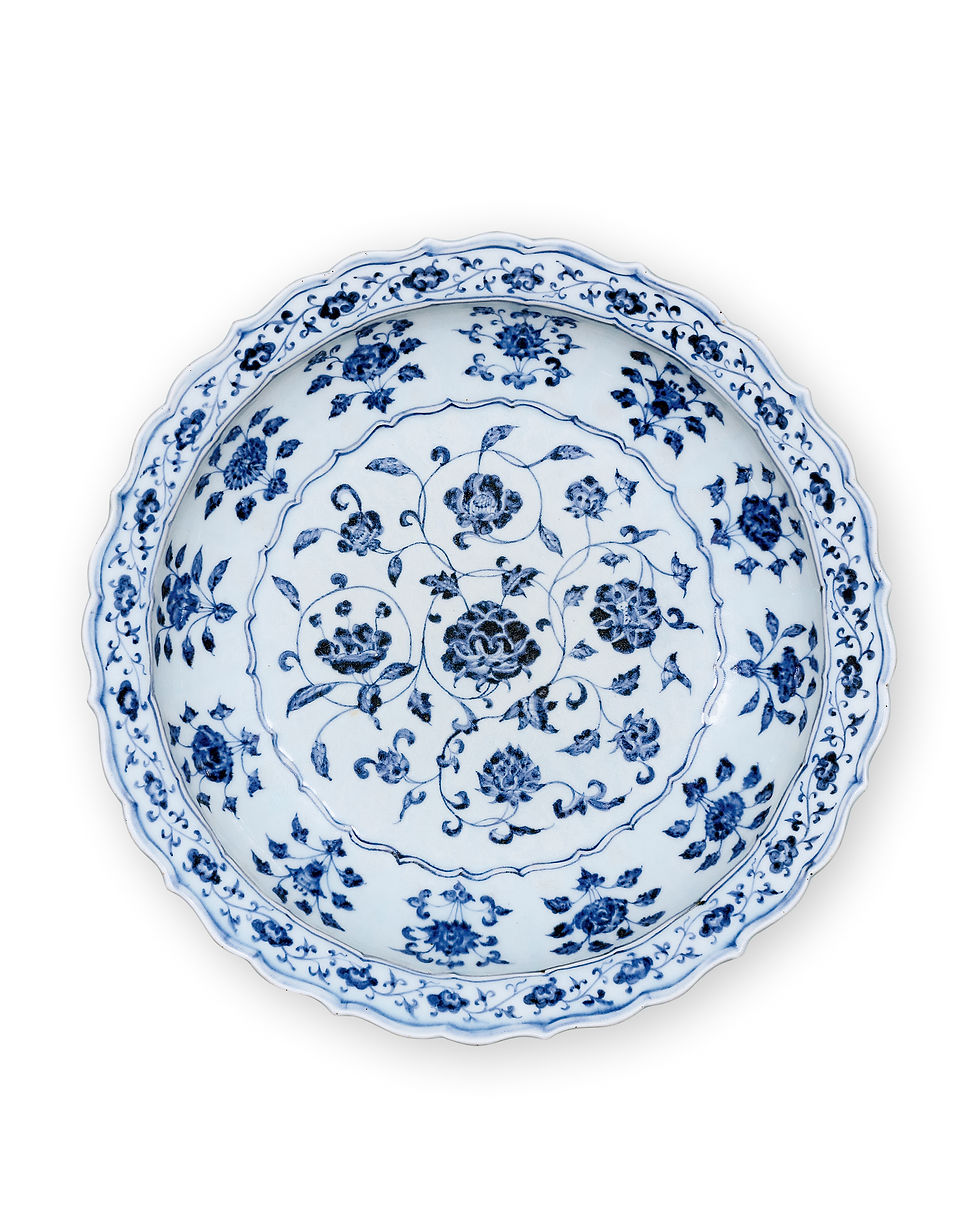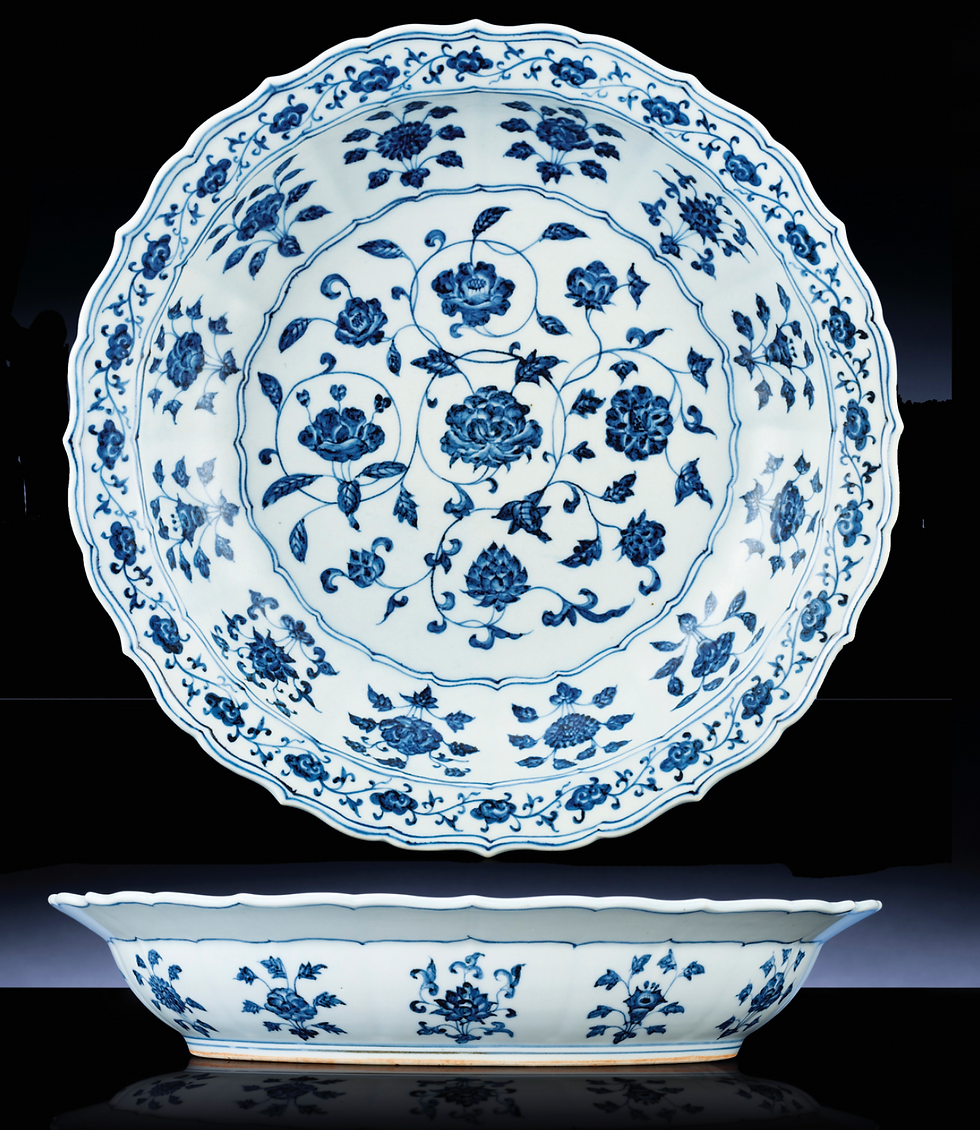保利筆記 Vol.5 埃斯肯納齊永樂盤327.75萬成交 - The Eyes of Eskenazi, A Very Rare Blue And White 'Floral' Flower-Shaped Dish.
- SACA
- Jun 10, 2024
- 6 min read
Updated: Jun 15, 2024
6405 明永乐 青花缠枝四季花卉葵口盘
w 38.3 cm
RMB: 2,850,000 - 3,850,000
英国重要私人收藏;
日本东京私人收藏;
英国古董商埃斯肯纳齐(Eskenazi Co.,)旧藏,编号C4066
上手圖片:
此盘为同类作品中尺寸偏大型者,葵口,折沿,浅腹,成十二瓣花形。整器以青花描绘花卉纹,盘内心绘缠枝花卉(有莲纹、牡丹、牵牛花等),内、外壁绘十二朵折枝花,分别莲花、牡丹、菊花、牵牛花等六种形态各异的四季花卉;折沿绘一周缠枝灵芝纹。砂底无釉,有自然微弱的火石红。
胎体细腻洁白,釉面肥厚滋润,釉色呈现淡淡的湖水青色。青花为进口的苏麻离青料,含铁量高,“铁锈斑”浓艳深沉,沁入胎骨;整器造型大方精巧,青花色泽恬静雅致,构图严谨,画功娴熟,双勾填色,小笔填涂,笔触浓淡不一,晕散自然,如同在宣纸上作画时留下的墨痕,富有风韵,当属青花瓷中典范。
与本品相似者,可见北京故宫博物院及台北故宫博物院所藏,尺寸相当;上海博物馆藏有一件同款宣德时期的作品。
This dish is one of the largest of its kind, with a sunflower mouth, a folded rim, and a shallow belly, in the form of a twelve-petalled flower. The whole vessel in blue and white to depict floral motifs, the disc within the inner painting twined flowers (lotus, peony, petunia, etc.), the inner and outer walls painted twelve twelve flowers, respectively, lotus, peony, chrysanthemum, petunia and other six kinds of seasonal flowers in different forms; folded edge painted one week twined Ganoderma lucidum pattern. The sandy base is unglazed, with a natural, faint flint red colour.
The carcass is delicate and white, the glaze is rich and moist, and the glaze is a pale lake-green colour. The blue and white porcelain is imported from Suma Li Qing material, with high iron content, and the ‘rust spots’ are rich and deep, penetrating into the bones; the whole vessel has a generous and delicate shape, and the blue and white colours are quiet and elegant, with a strict composition and skilful painting skills, with double hooks to fill in the colours, and a small brush to fill in the paint, with varying strokes of light and darkness, and with natural fainting, as if it were an ink mark left behind in the painting on the Xuanpian paper, with a lot of charm and charm, which is an excellent example of blue-and-white porcelain. It is a model of blue and white porcelain.
Similar to this example, it can be seen in the collections of the Palace Museum in Beijing and the National Palace Museum in Taipei, where it is of comparable size, and in the Shanghai Museum, where there is a copy of the same work from the Xuande period.
明宣德 青花缠枝莲纹花口盘 上海博物院藏
明永乐 青花缠枝花纹花口盘 清宫旧藏 故宫博物院藏
明永乐 青花四季花卉纹莲花式盘 台北故宫博物院藏
市場往期成交紀錄:
佳士得 25 Sep 2020
Price realised USD 1,470,000
Estimate USD 200,000 – USD 300,000
佳士得 31 May 2010
Price realised HKD 6,020,000
Estimate HKD 3,000,000 – HKD 4,000,000
Bonhams 28 Nov 2009
Sold for HK$ 2,280,000 inc. premium
明永樂 青花纏枝花卉紋折沿葵口盤
A MAGNIFICENT AND EXTREMELY RARE BLUE AND WHITE BARBED DISH
Yongle
Very finely moulded and shaped, a feat of technical accomplishment, the large dish of flattened circular form gently rising at the sides to a pronounced everted rim, the cavetto neatly moulded into twelve sections, the rim barbed at each section, forming twenty-four near symmetrical lobes, brilliantly painted in bold tones of cobalt-blue with characteristic 'heaping and piling' effect with a central peony flower surrounded by a lotus, camellia, hibiscus and gardenia all depicted in blossom and bud amidst meandering scroll, the draftsmanship rendered in a spontaneous and energetic manner, reminiscent of a master calligrapher, especially in the lively rendering of the vines and foliage, the twelve-panel cavetto painted with six flowers (camellia, morning glory, lotus, peony, chrysanthemum and pomegranate) repeated in two sections, the underside with similar decoration, the rim with a continuous lingzhi scroll, applied throughout with an exquisite smooth glaze, the underside unglazed revealing a subtle red film of iron.
38cm (15in) diam.
Footnotes
Large blue and white porcelain dishes of the Yongle period can be found in various museum and private collections. Drawing on the traditions of the Yuan court, in the early Ming dynasty large scale dishes continued to be commissioned for the Imperial court. The select group of large barbed dishes produced in the Yongle period represents the pinnacle of porcelain production in the early Ming period. To fire such a large, complex dish was a technical accomplishment; to paint it so finely with such delicate depiction of floral motifs was an improvement of an earlier innovation.
The present dish belongs to a group of barbed rim dishes all of similar size (around 38cm diameter) and painted in the same manner with a central composite floral scroll surrounded by individual blooms. For examples from the Qing court collection, see a dish in the National Palace Museum, Taiwan, illustrated Porcelain of the National Palace Museum: Blue-and-White Ware of the Ming Dynasty, Vol.1, Hong Kong, 1963, pl. 22; and a dish in the Palace Museum, Beijing, illustrated in Mingchu Qinghuaci, Beijing, 2002, pl. 134.
For other examples that have been preserved outside of the former Imperial collection, see two very similar dishes illustrated in Mayuyama, Seventy Years, Vol.I, Tokyo, 1976, p.252, fig.762, and another given to the British Museum by Mrs Walter Sedgwick, illustrated by J.Harrison-Hall, Ming Ceramics in the British Museum, London, 2001, p.116, fig.3:35, where it is noted that a large dish of this shape was excavated at the Yongle stratum at Dongmentou, Zhushan, Jingdezhen in 1994.
Eleven examples which found their way to the Middle East, where they were highly prized, were donated to the Ardebil Shrine by Shah Abbas the Great of Persia in 1611. Three of these are illustrated by J.A.Pope, Chinese Porcelains from the Ardebil Shrine, Washington, 1981, pl.35, 29.101, 106 and 109 and it is noted that nine of the dishes are inscribed with the mark of Qarachaghay.
The barbed rim and moulded cavetto can also be seen on a larger dish in the Peabody Essex Museum, illustrated by J.C.Y.Watt and D.Patry Leidy, Defining Yongle. Imperial Art in Early Fifteenth Century China, New York, 2005, pl.1 and another illustrated by J.Carswell, Blue and White. Chinese Porcelain Around the World, London, 2000, fig.99.
明朝永樂年間生產的藍白搭配大型青花瓷盤,當今見於世界各博物館及私人收藏。明代早期延續元代遺風,由朝廷委託民間製造大型瓷盤供宮內使用。此次拍賣的大型葵口盤,皆生產於明初永樂年間,可謂中國瓷器生產登峰造極之年代:此類巨大又繁複的盤具,烤燒十分不易,需要先進的技術,而如此細膩的花卉畫工,則比起元朝有過之而無不及。
本作品乃出自一批大小相似(皆為10釐米直徑)、花樣相同(中央有纏枝蓮紋、周邊環繞個別花朵)的葵口瓷盤。清宮所藏類似作品見於台北故宮博物院(見《故宮瓷藏:明青花瓷一》第22圖 / 香港1963年出版),及北京故宮(見《故宮博物院藏明初青花瓷》第134圖,北京2002年出版)。
宮廷以外亦有類似作品保存。《創業七十周年 : 龍泉集芳》(Mayuyama, seventy years) 第一冊(東京1976年出版)252頁第762圖中便繪有兩件極為相似的瓷盤。另在 J. Harrison-Hall 所著 《Ming Ceramics in the British Museum》 一書116頁第3:35圖中,亦繪有藏於大英博物館的類似葵口盤。書中說明此瓷盤乃由Walter Sedgwick 夫人贈予大英博物館,並提到類似的大型葵口盤曾於1994年在景德鎮珠山東門頭的永樂層出土。
另有十一件此類葵口盤傳到中東被視為瑰寶,1611年被波斯的阿巴斯大帝(Shah Abbas the Great of Persia)捐贈給阿德比耳寺 (Ardebil Shrine) ──其中有三件繪於 J.A. Pope 所著《Chinese Porcelains from the Ardebil Shrine》 (1981年華盛頓出版)第35、29.101、106及109圖。書中並註明其中有九個葵口盤上面印有Qarachaghay可汗字樣。類似的模製折腰類葵口盤亦見於美國麻州畢巴帝艾塞克斯博物館 (Peabody Essex Museum) ──J.C.Y.Watt 與 D.Patry Leidy 所著《Defining Yongle. Imperial Art in Early Fifteenth Century China》 (紐約 2005年出版) 第一圖與J.Carswell 著《Blue and White. Chinese Porcelain Around the World》(倫敦2000年出版)第99圖皆有所記載。
拍賣時間:6 月 15 日(星期六)
拍卖厅 A 順延
下載本場圖錄:







































Comments